Index to Trees & Shrubs in the Order Malvales
Family: Malvaceae (Cotton Family)
467. Adansonia digitata Baobab https://africawild-forum.com/viewtopic. ... 70#p171670
460. Grewia hexamita Giant Raisin https://africawild-forum.com/viewtopic. ... 23#p507323
X707. Hibiscus rosa-sinensis Chinese Cotton Rose https://africawild-forum.com/viewtopic. ... 72#p171672
464. Hibiscus tiliaceus tiliaceus Lagoon Hibiscus, Wild Cottontree https://africawild-forum.com/viewtopic. ... 80#p298480
Africa Wild Tree & Shrub Book - Order Malvales
Moderator: Klipspringer
Re: Africa Wild Tree & Shrub Book - Order Malvales
467. Baobab Adansonia digitata
Order: Malvales. Family: Malvaceae

Description
The main stem of larger baobab trees may reach enormous proportions of up to 28 m in girth. Although baobab trees seldom exceed a height of 25 m. The massive, usually squat cylindrical trunk gives rise to thick tapering branches resembling a root-system, which is why it has often been referred to as the upside-down tree. There is a tale which tells of how God planted them upside-down. Many traditional Africans believe that the baobab actually grows upside-down.
The stem is covered with a bark layer, which may be 50-100 mm thick. The bark is greyish brown and normally smooth but can often be variously folded and seamed from years of growth. The leaves are hand-sized and divided into 5-7 finger-like leaflets. Being deciduous, the leaves are dropped during the winter months and appear again in late spring or early summer.
The large, pendulous flowers (up to 20cm in diameter) are white and sweetly scented. They emerge in the late afternoon from large round buds on long drooping stalks from October to December. The flowers fall within 24 hours, turning brown and smelling quite unpleasant. Pollination by fruit bats takes place at night.
The fruit is a large, egg-shaped capsule (often >12cm), covered with a yellowish brown hairs. The fruit consists of a hard, woody outer shell with a dry, powdery substance inside that covers the hard, black, kidney-shaped seeds. The off-white, powdery substance is apparently rich in ascorbic acid. It is this white powdery substance which is soaked in water to provide a refreshing drink somewhat reminiscent of lemonade. This drink is also used to treat fevers and other complaints.
This tree is slow growing, mainly due to the low rainfall it receives.
Distribution
The baobab tree is found in areas of South Africa, Botswana, Namibia, Mozambique and other tropical African countries where suitable habitat occurs. In South Africa it is found only in the warm parts of the Limpopo Province.
Habitat
It is restricted to hot, dry woodland on stoney, well drained soils, in frost-free areas that receive low rainfall.
Links: Wild About Trees; SAPPI Tree Spotting - Lowveld
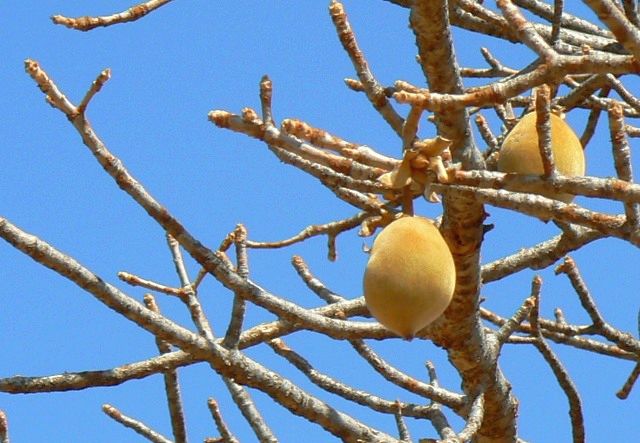 © Toko
© Toko
 © Lisbeth
© Lisbeth
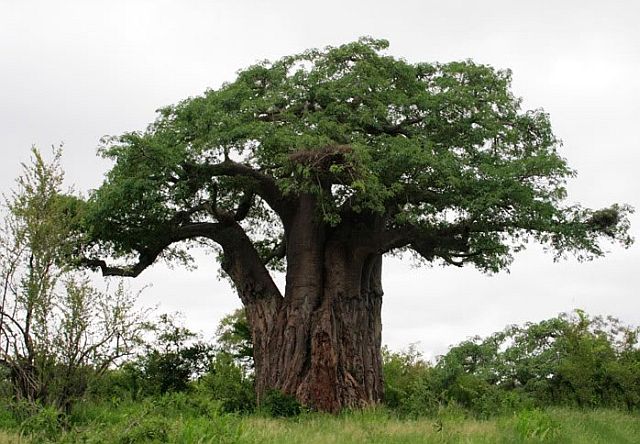 © leachy
© leachy
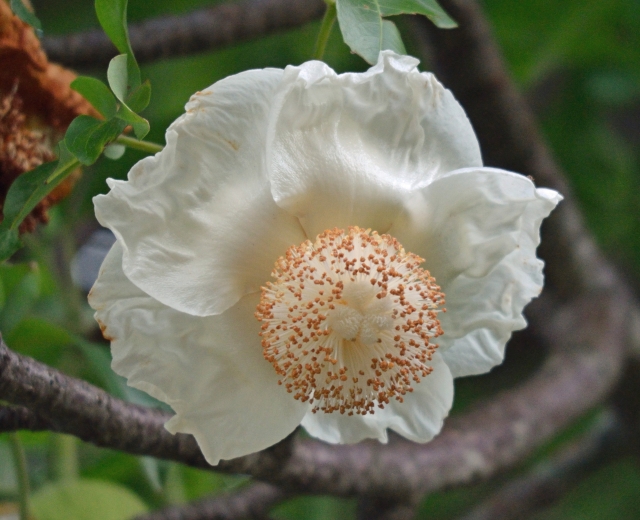 © BluTuna
© BluTuna
Kruger National Park
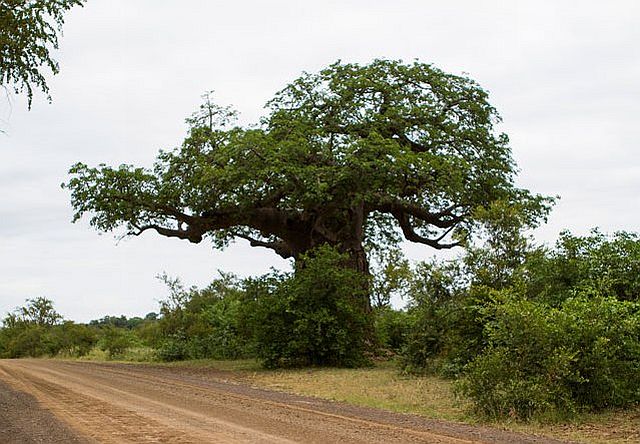 © Pumbaa
© Pumbaa
Kruger National Park
 © nan
© nan
Kruger National Park, H14
Order: Malvales. Family: Malvaceae

Description
The main stem of larger baobab trees may reach enormous proportions of up to 28 m in girth. Although baobab trees seldom exceed a height of 25 m. The massive, usually squat cylindrical trunk gives rise to thick tapering branches resembling a root-system, which is why it has often been referred to as the upside-down tree. There is a tale which tells of how God planted them upside-down. Many traditional Africans believe that the baobab actually grows upside-down.
The stem is covered with a bark layer, which may be 50-100 mm thick. The bark is greyish brown and normally smooth but can often be variously folded and seamed from years of growth. The leaves are hand-sized and divided into 5-7 finger-like leaflets. Being deciduous, the leaves are dropped during the winter months and appear again in late spring or early summer.
The large, pendulous flowers (up to 20cm in diameter) are white and sweetly scented. They emerge in the late afternoon from large round buds on long drooping stalks from October to December. The flowers fall within 24 hours, turning brown and smelling quite unpleasant. Pollination by fruit bats takes place at night.
The fruit is a large, egg-shaped capsule (often >12cm), covered with a yellowish brown hairs. The fruit consists of a hard, woody outer shell with a dry, powdery substance inside that covers the hard, black, kidney-shaped seeds. The off-white, powdery substance is apparently rich in ascorbic acid. It is this white powdery substance which is soaked in water to provide a refreshing drink somewhat reminiscent of lemonade. This drink is also used to treat fevers and other complaints.
This tree is slow growing, mainly due to the low rainfall it receives.
Distribution
The baobab tree is found in areas of South Africa, Botswana, Namibia, Mozambique and other tropical African countries where suitable habitat occurs. In South Africa it is found only in the warm parts of the Limpopo Province.
Habitat
It is restricted to hot, dry woodland on stoney, well drained soils, in frost-free areas that receive low rainfall.
Links: Wild About Trees; SAPPI Tree Spotting - Lowveld
 © Toko
© Toko © Lisbeth
© Lisbeth © leachy
© leachy © BluTuna
© BluTunaKruger National Park
 © Pumbaa
© PumbaaKruger National Park
 © nan
© nanKruger National Park, H14
Re: Africa Wild Tree & Shrub Book - Order Malvales
X707. Rose Mallow, Chinese Hibiscus, China Rose, Chinese Cotton Rose Hibiscus rosa-sinensis
Order: Malvales. Family: Malvaceae
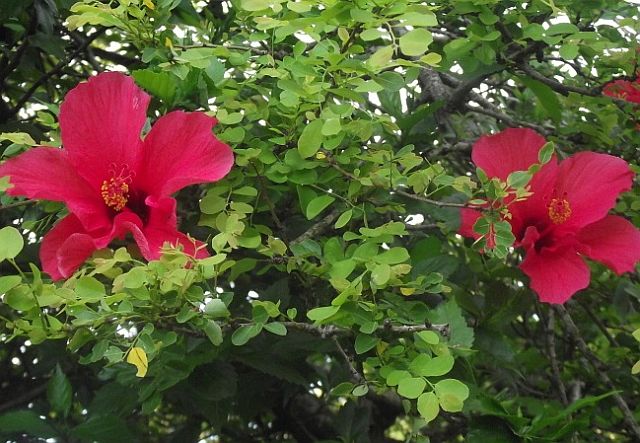 © mposthumus
© mposthumus
 © mposthumus
© mposthumus
Kruger National Park, Pretoriuskop Camp
Description
Hibiscus rosa-sinensis is a bushy, evergreen shrub or small tree growing 2.5–5 m tall and 1.5–3 m wide, with glossy leaves and solitary, brilliant red flowers in summer and autumn. The 5-petaled flowers are 10 cm in diameter, with prominent orange-tipped red anthers.
Distribution
This is a garden species, not native to South Africa, the most commonly grown species of Hibiscus in South African gardens. Native to tropical Asia and China. It is common in KwaZulu-Natal, so much so that part of the southern coast is named after this flower.
Links: Bill Sheat, Gerald Schofield: Complete Gardening in Southern Africa
Order: Malvales. Family: Malvaceae
 © mposthumus
© mposthumus © mposthumus
© mposthumusKruger National Park, Pretoriuskop Camp
Description
Hibiscus rosa-sinensis is a bushy, evergreen shrub or small tree growing 2.5–5 m tall and 1.5–3 m wide, with glossy leaves and solitary, brilliant red flowers in summer and autumn. The 5-petaled flowers are 10 cm in diameter, with prominent orange-tipped red anthers.
Distribution
This is a garden species, not native to South Africa, the most commonly grown species of Hibiscus in South African gardens. Native to tropical Asia and China. It is common in KwaZulu-Natal, so much so that part of the southern coast is named after this flower.
Links: Bill Sheat, Gerald Schofield: Complete Gardening in Southern Africa
Re: Africa Wild Tree & Shrub Book - Order Malvales
464. Lagoon Hibiscus, Wild Cottontree Hibiscus tiliaceus tiliaceus (Katoenboom)
Order: Malvales. Family: Malvaceae
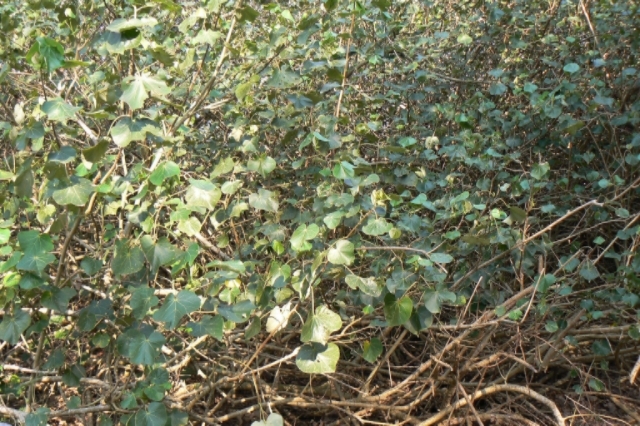
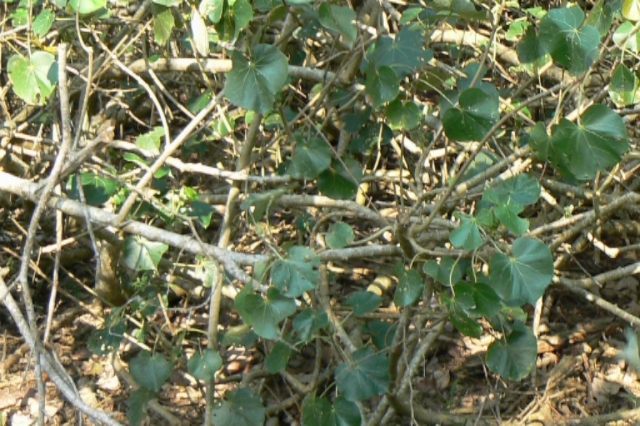
St. Lucia
Description
A large, stout, open-branched shrub or small tree with spreading branches. It grows to a height of 3–6 m. Stems long and flexible. Young branches, buds and flowers densely covered with short soft hairs. Bark pale greyish brown, smooth or with lenticels (small corky dots on young stems allowing gas exchange between plant and environment), becoming rough with age.
Large dark green simple leaves are heart-shaped to almost circular, or broader than long, 30–150 mm in diameter or larger; 5- to 9-veined from the base, veins prominent, each of the main veins with a slit or elongated gland near the base; velvety white to greyish, densely and finely tomentose below, olive-green and glabrescent (becoming hairless) on the upper surface; apex abruptly pointed; base deeply lobed; margins entire or minutely toothed; petiole (leaf stalk) up to120 mm long, with stellate (star-shaped) hairs, sometimes hairless; stipules (small appendages at the base of leaves) broad, up to about 30 x 15 mm, ovate-cordate, caducous (falling off during the life of the organism), sheathing the stem, falling off early to leave a scar almost all the way around the stem. The inflorescence seems to be cymose (as in an inflorescence in which the main axis and all side branches end in a flower) but the apparently terminal flowers are really axillary (arising from the axil of a leaf). Bracts (modified leaves associated with flower) ovate; paired with the stipules, each pair occupies the complete circumference of the stem leaving a circular scar after falling off.
Flowers large, showy, up to 120 mm in diameter, yellow with dark maroon or blackish centre, deepen to orange or apricot as they mature, flowers fading after 1 day and turn orange-red before they are shed. Flowers have five free petals 60 –70 x 40–60 mm, obovate, twisted. the stamens many, united into a distinctive tube up to 25 mm long around the style.
Fruit an ovoid or subglobose capsule, tapering to the apex, 20–25 mm long, covered with golden hairs. Seeds almost kidney-shaped, 4.5 x 3 mm, smooth.
Distribution
It occurs along the coast from the Eastern Cape to Zululand and extends into the tropics.
Habitat
Widespread along the sea shore on margins of watercourses or in tidal zone thickets. It fringes estuaries and coastal areas along rivers and lagoons. It usually occupies higher ground than the mangroves.
Order: Malvales. Family: Malvaceae


St. Lucia
Description
A large, stout, open-branched shrub or small tree with spreading branches. It grows to a height of 3–6 m. Stems long and flexible. Young branches, buds and flowers densely covered with short soft hairs. Bark pale greyish brown, smooth or with lenticels (small corky dots on young stems allowing gas exchange between plant and environment), becoming rough with age.
Large dark green simple leaves are heart-shaped to almost circular, or broader than long, 30–150 mm in diameter or larger; 5- to 9-veined from the base, veins prominent, each of the main veins with a slit or elongated gland near the base; velvety white to greyish, densely and finely tomentose below, olive-green and glabrescent (becoming hairless) on the upper surface; apex abruptly pointed; base deeply lobed; margins entire or minutely toothed; petiole (leaf stalk) up to120 mm long, with stellate (star-shaped) hairs, sometimes hairless; stipules (small appendages at the base of leaves) broad, up to about 30 x 15 mm, ovate-cordate, caducous (falling off during the life of the organism), sheathing the stem, falling off early to leave a scar almost all the way around the stem. The inflorescence seems to be cymose (as in an inflorescence in which the main axis and all side branches end in a flower) but the apparently terminal flowers are really axillary (arising from the axil of a leaf). Bracts (modified leaves associated with flower) ovate; paired with the stipules, each pair occupies the complete circumference of the stem leaving a circular scar after falling off.
Flowers large, showy, up to 120 mm in diameter, yellow with dark maroon or blackish centre, deepen to orange or apricot as they mature, flowers fading after 1 day and turn orange-red before they are shed. Flowers have five free petals 60 –70 x 40–60 mm, obovate, twisted. the stamens many, united into a distinctive tube up to 25 mm long around the style.
Fruit an ovoid or subglobose capsule, tapering to the apex, 20–25 mm long, covered with golden hairs. Seeds almost kidney-shaped, 4.5 x 3 mm, smooth.
Distribution
It occurs along the coast from the Eastern Cape to Zululand and extends into the tropics.
Habitat
Widespread along the sea shore on margins of watercourses or in tidal zone thickets. It fringes estuaries and coastal areas along rivers and lagoons. It usually occupies higher ground than the mangroves.
-
Klipspringer
- Global Moderator
- Posts: 5858
- Joined: Sat Sep 14, 2013 12:34 pm
- Country: Germany
- Contact:
Re: Africa Wild Tree & Shrub Book - Order Malvales
460. Giant Raisin Grewia hexamita
Order: Malvales. Family: Malvaceae
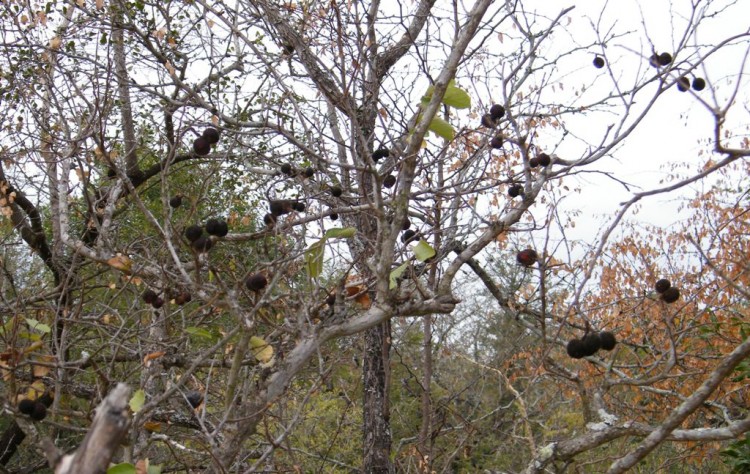 © Richprins
© Richprins
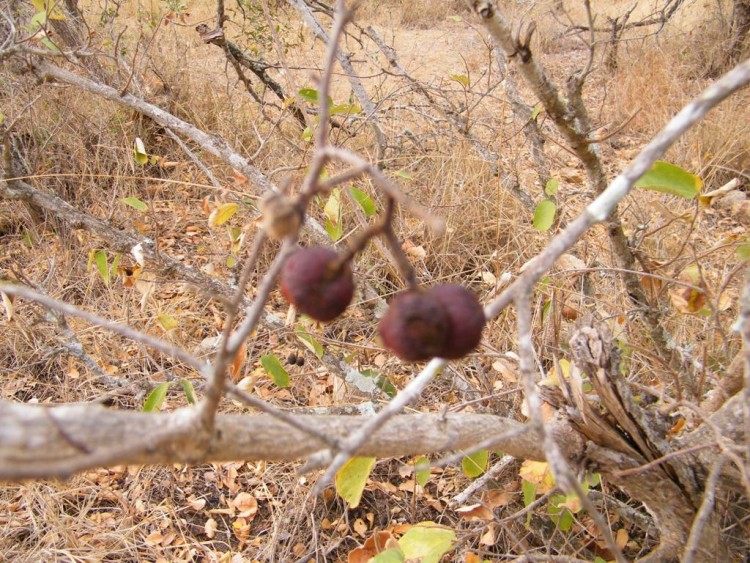 © Richprins
© Richprins
 © Richprins
© Richprins
Marloth Park, June 2020


Same tree in October 2020
Description
A large, multi-stemmed shrub or small tree, 5 m high. It has a rough, dark grey bark. The branches are reddish brown, with conspicuous lenticels, and are covered in reddish hairs when young. The leaves are alternate and elliptic to oblong-elliptic, 30-100 x 25-60 mm, with a rounded or tapering apex. They are 3-veined from the asymmetrically lobed base, leathery, dark glossy green above and paler below, and the margins are serrated. The leaf stalk is about 3-6 mm long.
The flowers are regular, bisexual and have 5 petals, golden yellow, large, about 50 mm in diameter and there are 2 or 3 per stalk. The buds are velvety and reddish. The flowers are honey-scented and arranged in axillary clusters at the end of branches. The flowering time is September-December.
The fruits are large, round and shiny, reddish brown drupes, entire to deeply 2-lobed, up to 20 mm in diameter.
Distribution
Mozambique, Zimbabwe, eSwatini, in South Africa it is found in KwaZulu-Natal, Limpopo, Mpumalanga.
Habitat
In dry deciduous woodland, often in river valleys.
Ecology
The giant raisin's lovely scented flowers attract butterflies and birds. Bigger birds like Francolins and Guineafowl consume the fruit. Other animals that eat the fruit include Baboons, Elephant, Giraffe, Kudu, Monkeys and Warthogs. The seeds that have passed through the stomach of these animals germinate rapidly, presumably due to the stomach acids that help to dissolve the tough seed coat. The leaves are browsed by game and livestock.
Name derivation: Grewia named after Nehemiah Grew (1641-1712) who was an English plant anatomist. hexamita – 6 threads: meaning is unclear.
Common names: giant raisin, large-flowered grewia, Lowveld grewia (Eng.); reuserosyntjie, blinkblaarrosyntjie (Afr.); umsiphane (Swazi); nsihana, guguna, nsihani, sipane (Tsonga); mukunukunu (Venda); umlalampunzi, imdliwampunzi (Zulu)
Links:
https://treesa.org/grewia-hexamita/
Order: Malvales. Family: Malvaceae
Marloth Park, June 2020
Same tree in October 2020
Description
A large, multi-stemmed shrub or small tree, 5 m high. It has a rough, dark grey bark. The branches are reddish brown, with conspicuous lenticels, and are covered in reddish hairs when young. The leaves are alternate and elliptic to oblong-elliptic, 30-100 x 25-60 mm, with a rounded or tapering apex. They are 3-veined from the asymmetrically lobed base, leathery, dark glossy green above and paler below, and the margins are serrated. The leaf stalk is about 3-6 mm long.
The flowers are regular, bisexual and have 5 petals, golden yellow, large, about 50 mm in diameter and there are 2 or 3 per stalk. The buds are velvety and reddish. The flowers are honey-scented and arranged in axillary clusters at the end of branches. The flowering time is September-December.
The fruits are large, round and shiny, reddish brown drupes, entire to deeply 2-lobed, up to 20 mm in diameter.
Distribution
Mozambique, Zimbabwe, eSwatini, in South Africa it is found in KwaZulu-Natal, Limpopo, Mpumalanga.
Habitat
In dry deciduous woodland, often in river valleys.
Ecology
The giant raisin's lovely scented flowers attract butterflies and birds. Bigger birds like Francolins and Guineafowl consume the fruit. Other animals that eat the fruit include Baboons, Elephant, Giraffe, Kudu, Monkeys and Warthogs. The seeds that have passed through the stomach of these animals germinate rapidly, presumably due to the stomach acids that help to dissolve the tough seed coat. The leaves are browsed by game and livestock.
Name derivation: Grewia named after Nehemiah Grew (1641-1712) who was an English plant anatomist. hexamita – 6 threads: meaning is unclear.
Common names: giant raisin, large-flowered grewia, Lowveld grewia (Eng.); reuserosyntjie, blinkblaarrosyntjie (Afr.); umsiphane (Swazi); nsihana, guguna, nsihani, sipane (Tsonga); mukunukunu (Venda); umlalampunzi, imdliwampunzi (Zulu)
Links:
https://treesa.org/grewia-hexamita/


